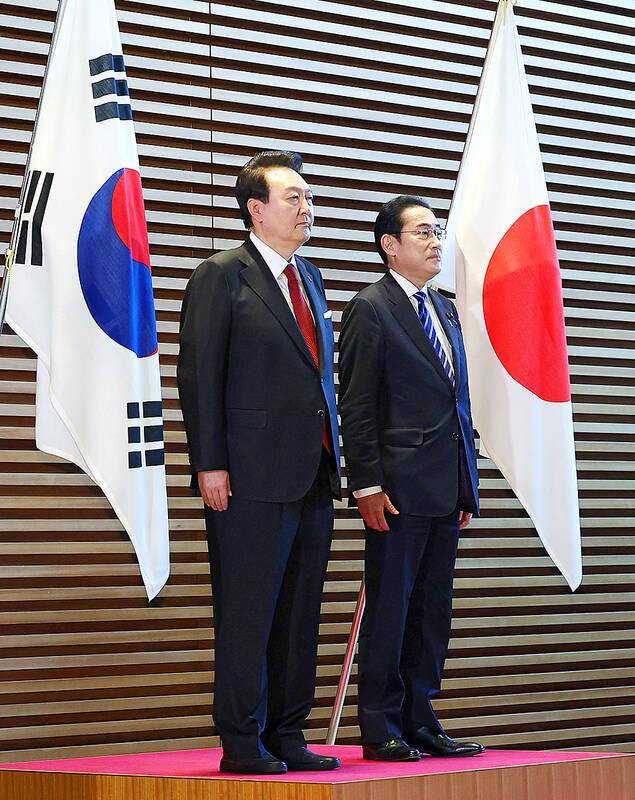Nearly everything about South Korean President Yoon Suk-yeol’s first summit with Japanese Prime Minister Fumio Kishida in Tokyo will be scrutinized for signs of warmer bilateral ties, including a shared meal of a Tokyo classic called omurice.
The dish, whose name is a mash-up of omelet and rice, has become the talk of the town since Japan’s Fuji TV reported on Monday of a hushed plan for Kishida to treat Yoon at Rengatei, the storied but no-frills restaurant that invented it.
Yoon, a self-described foodie and avid cook, reportedly had “unforgettable” memories of the omurice he ate in his youth at the 128-year-old establishment in Tokyo’s Ginza district. He made frequent trips to the Japanese capital in 1966 while his father, a university professor, spent a year there, he told the Yomiuri daily.

Photo: EPA-EFE
Japanese and South Korean officials have declined to confirm the plan or venue, while Rengatei, famed as the birthplace of omurice in 1900, declined to comment.
Although many foreigners might associate Japanese cuisine with sushi or tempura, yoshoku, or Western-influenced dishes such as omurice and tonkatsu (deep-fried pork cutlet), are more common fare on Japanese dinner tables.
Yoshoku is a genre of Japanese cuisine established more than a century ago, and some made its way to South Korea in the 1960s as ethnic Koreans traveled between the two countries, said Motoo Kawabata, a professor at Kwansei Gakuin University who specializes in Japanese restaurants’ global strategy.
Kishida and Yoon will reportedly share a more formal dinner of sukiyaki beforehand, but the real ice-breaker could be when they sit down for omurice, Kawabata said. Japan and South Korea are holding a summit for the first time in 12 years, seeking to mend relations that had deteriorated severely.
“It could be an effort to foster a laid-back mood, through a casual dish that both Japanese and Koreans consider comfort food,” he said.
Rengatei’s price for its omurice: 2,600 yen (US$19.57).
Kawabata said the omurice in South Korea typically has a thinner and firmer layer of eggs, while the image of a perfectly crafted one in Japan has a fluffy, runny, almond-shaped covering of eggs that blanket the ketchup-fried rice.
“Yoon may have been impressed with the softness of Japanese-style omurice,” Kawabata said.
Although Rengatei’s original dish mixed the egg batter in with the rice, the omurice as Japanese people know it today was conceived for and popularized in the 1985 Juzo Itami film Tampopo, a critically acclaimed meditation on food and one of Japan’s best known movies.
Hiroshi Modegi, the third-generation owner chef of Taimeiken, which appears in the film, said he was disappointed that his restaurant was not the president’s choice, but welcomed the renewed attention on omurice.
“I hope the world discovers that Japanese food culture also has a dish like this,” he said.

The Lee (李) family migrated to Taiwan in trickles many decades ago. Born in Myanmar, they are ethnically Chinese and their first language is Yunnanese, from China’s Yunnan Province. Today, they run a cozy little restaurant in Taipei’s student stomping ground, near National Taiwan University (NTU), serving up a daily pre-selected menu that pays homage to their blended Yunnan-Burmese heritage, where lemongrass and curry leaves sit beside century egg and pickled woodear mushrooms. Wu Yun (巫雲) is more akin to a family home that has set up tables and chairs and welcomed strangers to cozy up and share a meal

Dec. 8 to Dec. 14 Chang-Lee Te-ho (張李德和) had her father’s words etched into stone as her personal motto: “Even as a woman, you should master at least one art.” She went on to excel in seven — classical poetry, lyrical poetry, calligraphy, painting, music, chess and embroidery — and was also a respected educator, charity organizer and provincial assemblywoman. Among her many monikers was “Poetry Mother” (詩媽). While her father Lee Chao-yuan’s (李昭元) phrasing reflected the social norms of the 1890s, it was relatively progressive for the time. He personally taught Chang-Lee the Chinese classics until she entered public

Last week writer Wei Lingling (魏玲靈) unloaded a remarkably conventional pro-China column in the Wall Street Journal (“From Bush’s Rebuke to Trump’s Whisper: Navigating a Geopolitical Flashpoint,” Dec 2, 2025). Wei alleged that in a phone call, US President Donald Trump advised Japanese Prime Minister Sanae Takaichi not to provoke the People’s Republic of China (PRC) over Taiwan. Wei’s claim was categorically denied by Japanese government sources. Trump’s call to Takaichi, Wei said, was just like the moment in 2003 when former US president George Bush stood next to former Chinese premier Wen Jia-bao (溫家寶) and criticized former president Chen

President William Lai (賴清德) has proposed a NT$1.25 trillion (US$40 billion) special eight-year budget that intends to bolster Taiwan’s national defense, with a “T-Dome” plan to create “an unassailable Taiwan, safeguarded by innovation and technology” as its centerpiece. This is an interesting test for the Chinese Nationalist Party (KMT), and how they handle it will likely provide some answers as to where the party currently stands. Naturally, the Lai administration and his Democratic Progressive Party (DPP) are for it, as are the Americans. The Chinese Communist Party (CCP) is not. The interests and agendas of those three are clear, but